What is the difference between an induction cooker and glass-ceramic: a description of technical characteristics and an overview of popular models
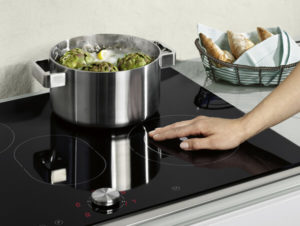 Choosing a stove in the kitchen, a person can not always understand what characterizes an induction stove, what is its principle of operation and how it differs from a glass-ceramic hob, powered by electricity, because the appearance of both of these devices is very similar.
Choosing a stove in the kitchen, a person can not always understand what characterizes an induction stove, what is its principle of operation and how it differs from a glass-ceramic hob, powered by electricity, because the appearance of both of these devices is very similar.
In the article, we will consider in detail each type of modern equipment for cooking, study the advantages and disadvantages, and conclude which version of the device will be the best solution for large and small kitchens.
Content
Induction cooker
Description
Induction cooker is the most modern kitchen equipment for cooking, based on heating metal utensils with an induced vortex flow, which is produced from a high-frequency magnetic field.
Heat in this process is sent directly to the pot or pan.
The induction cooker is similar in appearance to a device with a glass-ceramic hob.
An important difference is that the innovative stove does not have heating elements; their function is the bottom of the dish with ferromagnetic properties.
The cooking surface of such stoves is multifunctional, for example, it has a quick heating burner, a booster function (power transfer from one speaker to another), an audio timer and other options.
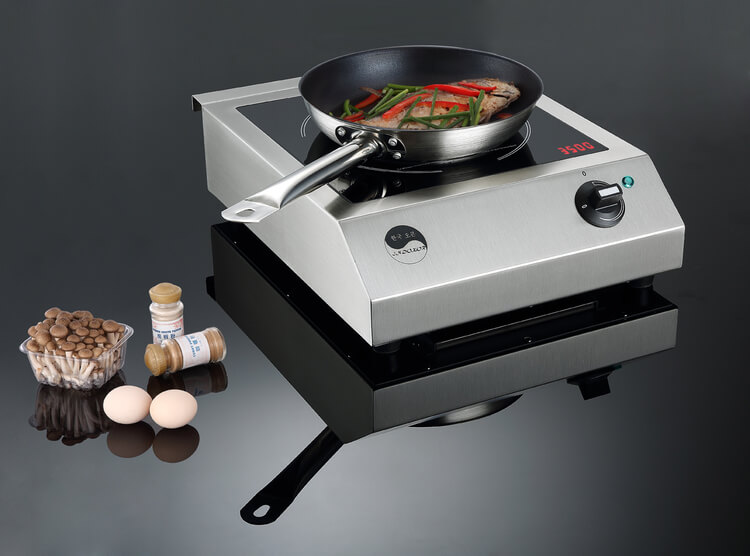
Principle of operation
The principle of operation of induction models is based on the phenomenon of electromagnetic induction, which was discovered by the English physicist M. Faraday in the early 19th century.
Induction cooker is a portable transformer. Under its surface of glass-ceramic there is an induction coil with a copper winding, through which an electric current flows, with a frequency of 20-60 kHz.
The current is transformed into electromagnetic fields and generates induction currents that cause the electronic particles of the bottom of the dishes (conductor with a closed loop) to move and heat up.
Views
There are several types of stoves with induction hob:
- A stove made in conjunction with an oven.
- Combined cooker - two burners on the product are powered by electricity, two - on the principle of induction.
- Built-in hob. A convenient option for a small kitchen, under it you can install special drawers for storing dishes.
- Tabletop stove. A convenient option for the cottage, on the road or for one person.
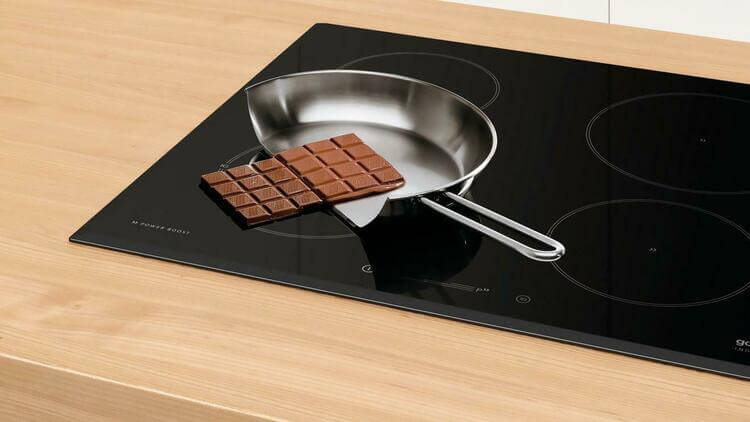
Advantages and disadvantages
pros
- high speed cooking, thanks to the rapid heating of the bottom of the dishes, and not the hob;
- economical energy consumption;
- during cooking, the air in the kitchen almost does not heat up;
- high safety of the device, due to the automatic switching on and off of the stove when dishes are placed on or removed;
- minimal risk of burns due to the cold edge of the burner;
- the surface is easy to clean, since dirt, food and grease do not burn and do not form smoke - just wipe it with a damp sponge or rag;
- instant change in temperature accurate to a degree;
- the plate adapts to the bottom of the dishes and heats it to the desired temperature;
- the hob will not work if you put on it dishes, with a diameter of less than 12 cm, so it will not turn on if a spoon or other object is accidentally hit on it;
- the device is equipped with many important and life-saving hostesses programs - boiling water, stewing vegetables, etc.
Minuses
- high cost of the device - you need to pay a lot for good functionality and convenience;
- it is necessary to use special dishes with a bottom having ferromagnetic properties - it will provide economy, safety and efficiency (the bottom can be checked with an ordinary magnet);
- the glass ceramic surface is very fragile, it is important to exclude accidental point impacts to avoid cracks and chips;
- do not clean the plate with abrasive powders and hard sponges;
- when the device is working, noise is heard - a buzz or buzz;
- the induction panel must not be installed next to other household appliances (washing machine, dishwasher, oven), as it can adversely affect their operation.
Glass-ceramic plate
Description
Glass-ceramic kitchen equipment is a type of electric stove. The glass-ceramic hob is made of a special material - cerana, which has high strength and the ability to withstand shock of any strength.
The glass-ceramic panel is characterized by a mirrored and absolutely smooth surface on which two types of electric burners are located:
- ordinary;
- double-circuit - designed to control the level of heating, depending on the size of the dishes.
In addition to heating elements, the stove is equipped with an oven.

Principle of operation
The main working elements of the glass-ceramic plate are instantly heated using a tubular electric heater. From it, through the glass surface, heat passes, which heats the dishes.
Halogen burners with heat-generating bulbs or the most modern Hi Light burners are mounted in glass-ceramic panels - they are heated from a specially fused tape in the form of a snake.
The principle of operation of such a plate is similar to the performance of a regular plate with cast-iron pancakes. The heating element itself increases the heat and conducts it to a pan or pan.
Kinds
Glass-ceramic plates are distinguished by a variety of burners.
They come in three types:
- burners with a heating element in the form of a halogen bulb - warm up in 3 seconds, powerful, but do not last long;
- Rapid burners - warm up in 12 seconds, the role of the heating element is played by a spiral with high resistance. An improved version of such modern burners is Hi Light, they are able to warm up in 7 seconds;
- induction hobs - heating occurs instantly, and energy is carefully saved. However, the price of stoves with this type of burner is very high.

Advantages and disadvantages
pros
- vertical thermal conductivity, due to which thermal energy falls only on the bottom of the dishes, and not the entire cooking surface. Glass-ceramic plate is able to withstand heating up to 600 degrees;
- quick cooling of the hob - changing the position of the switch, you can adjust the desired temperature of the heating element;
- different cooking temperature ranges;
- careful consumption of electricity, due to the fact that the heating elements adapt to different diameters of dishes;
- boiling water control function - greatly reduces the likelihood of contamination;
- ovens have lighting, ventilation, heating sensors, grill and rotisserie, a steam self-cleaning system;
- child protection, blocking access to the stove control;
- high strength of the hob, thanks to the material - cerane;
- the possibility of using dishes of original forms (coop, cauldron, etc.);
- the smooth mirror surface of the hob fits perfectly into the kitchen and ennobles it.
Minuses
- in many models it is necessary to use utensils made of certain materials, preferably with a flat, thick and matte bottom (utensils made of ceramics, glass, aluminum and copper are not suitable);
- difficulty in maintenance - you need to clean the stove with a special tool - a scraper with a thin blade, and expensive household cleaning products created specifically for glass ceramics, otherwise oxidation and micro-scratches can be provoked;
- point and excessive loads on the surface are contraindicated;
- due to low sides, escaped milk or soup may drain to the floor;
- a glass-ceramic plate cannot be stained with sugar products, since such contaminants can hardly be wiped off;
- A sharp temperature difference is contraindicated for these models, as this puts home appliances out of order.
Comparison of induction and glass ceramic stoves
| Specifications | Induction cooker | Glass-ceramic plate |
| Suitable cookware | Special dishes with a flat bottom and ferromagnetic properties | Utensils of completely different shapes, do not use old utensils |
| Heating rate | Almost instantly | A couple of minutes |
| Efficiency | About 90% | About 60% |
| Cost-effectiveness | Consumes less electricity, cheaper | Consumes more electricity |
| Safety | The hob is safe for children and animals, it is not recommended for people with pacemakers | Less dangerous than gas, but there is a risk of burns. |
| Noise | Pretty quiet sounds, buzz | Silent |
| Care | Liquids and food are easily removed with a damp cloth. | Contaminants are easily removed, except for food from sugar |
| Control | Auto power on, touch control | Mechanical or sensory activation and regulation |
The conclusion suggests itself: in attempts to save money on kitchen equipment, it is better to give preference to a glass-ceramic stove.
However, if you want to save time and effort, it is better to choose an induction one, because it cooks faster and is easier to clean. Also, the induction panel is good in that it consumes much less electricity, as it heats up faster and has a function for automatically controlling the temperature of the burners.
But the big plus of the glass ceramic plate is its absolutely silent operation, which cannot be said about its opponent.
The choice is always up to the buyer: an expensive, but the most modern product, freeing up time for the personal affairs of the owner; or a device in the middle price segment, but causing some discomfort in the care and operation.
Both a glass-ceramic stove and a device that works on the principle of induction can save space in a small kitchen, because it can be built into furniture or put on a work surface.
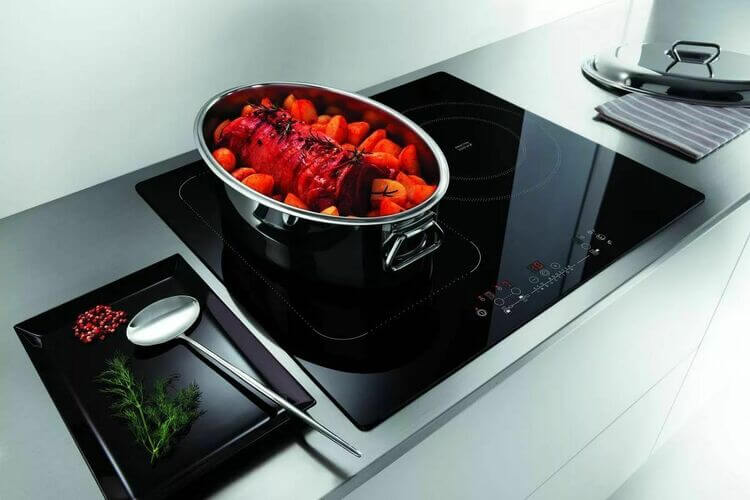
TOP 5 induction cookers
Hansa bhi68300
Electric induction cooker in a stylish minimalist black design.  Sensor temperature control and built-in functions will be clear to any cook.
Sensor temperature control and built-in functions will be clear to any cook.
The equipment is very powerful and heats up instantly.
Specifications:
- surface type - electric hob;
- location - independent;
- dimensions - 60 * 50 cm;
- power - 7 kW;
- panel material - glass-ceramic;
- number of burners - 4;
- regulation - touch, buttons;
- timer - yes;
- hob lock - yes;
- residual heat indicator - yes;
- the shade is black.
pros
- intuitive regulation;
- good power;
- stylish appearance;
- child lock;
- sound timer.
Minuses
- at automatic shutdown all rings cease to work;
- There is an unpleasant smell at work.
Electrolux EHF 96547 XK
Multifunctional induction cooker: boiling, shutdown during the spill 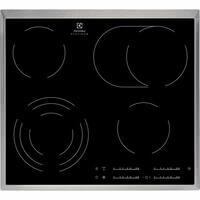 liquids, protection against children and animals, etc..
liquids, protection against children and animals, etc..
Heating elements have many options, and the hob itself can be placed anywhere and even built into the headset.
Specifications:
- surface type - electric hob;
- location - independent;
- dimensions - 57.6 * 51.6 cm;
- power - 7.1 kW;
- panel material - glass-ceramic;
- number of burners - 4;
- number of burners Hi Light - 4;
- the number of three-circuit - 1;
- the number of desks with an oval heating zone - 1;
- regulation - touch, slider;
- timer - yes, sound;
- hob lock - yes;
- residual heat indicator - yes;
- shade - black with silver.
pros
- convenient to care for;
- excellent ratio of quality and price;
- many options;
- clear management.
Minuses
- black is very easily soiled;
- short power cord;
- high energy consumption.
Bosch PIE631FB1E
German induction cooker has convenient buttons on the touch panel, function  automatic recognition of dishes on the surface.
automatic recognition of dishes on the surface.
The device informs about the completion of cooking and blocks the hob from animals and children.
Specifications:
- surface type - electric hob;
- location - independent;
- dimensions - 59.2 * 52.2 cm;
- power - 7.4 kW;
- panel material - glass-ceramic;
- number of burners - 4;
- regulation - touch, buttons;
- timer - yes, with sound;
- hob lock - yes;
- residual heat indicator - yes;
- the shade is black.
pros
- there is a Boost mode - instant boiling of water;
- uniform heating in all modes;
- sound notification;
- Beautiful design.
Minuses
- the surface is easily scratched;
- there is little noise in boost mode.
Fornelli pga 45 fiero
The plate is made in tempered glass. The arsenal has a wok burner with a triple flame  for instant heating of food.
for instant heating of food.
For burners, both flat bottoms of dishes and spherical ones are suitable.
Specifications:
- surface type - gas cooking;
- location - independent;
- dimensions - 45 * 51 cm;
- panel material - tempered glass;
- number of burners - 3;
- regulation - rotary;
- timer - yes;
- the shade is black.
pros
- compactness;
- turbo burner works well;
- easy to care.
Minuses
- handles are not very high quality;
- electric burning may not work.
Hotpoint-Ariston IKIA 640 C
Induction cooker with automatic dish recognition. Sound timer 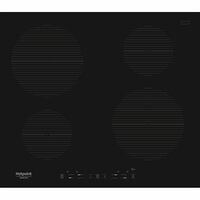 can be set for a specific cooking time.
can be set for a specific cooking time.
The stove saves electricity, because it heats up almost immediately when turned on.
Specifications:
- surface type - electric hob;
- location - independent;
- dimensions - 59 * 51 cm;
- power - 7 kW;
- panel material - glass-ceramic;
- number of burners - 4;
- regulation - touch, buttons;
- timer - yes;
- hob lock - yes;
- residual heat indicator - yes;
- the shade is black.
pros
- touch panel for control;
- quality hob material;
- works almost without sounds
- aristocratic stylish design.
Minuses
- the induction panel often gets dirty, you have to wipe it with a damp cloth after each use.
Useful video
From the video you will learn how the induction cooker differs from glass ceramic:

Well, I don’t know, all these disadvantages that you described are not so scary. I also have Hotpoint-Ariston, I don’t think it cost me a lot, especially since such a stove is much more convenient and functional
I liked the option of glass-ceramic tiles. Only here the number of the given minuses confuses. It is clear that there are always disadvantages, especially in technology. The question is how much they spoil the overall picture of using such a stove.
You know, I would never say that the induction cooker has some kind of high cost, since I generally bought my indesite at an affordable price and am happy.
I do not agree that induction is often dirty. I have a whirlpool induction. Her surface is excellent, not easily soiled. Stains, dirt or fingers are not very visible